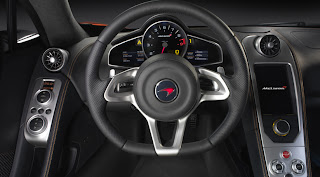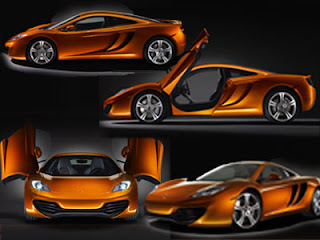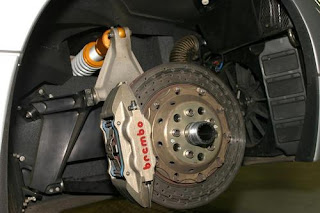Well those of you who read m article last week should understand well enuf what im talking about :P.
If you have'nt, I suggest you start off by reading that first. Its got some pretty intresting, never easy to hear stuff…… (If you are a car enthusiast right to the hilt!!!!).
So leaving all that aside.. heres to the successor. The McLaren MP4-12c. Harldy a name that’s easy to remember….. bt definitely not the type to forget if you see it once. Sit back and scroll through its beauty.
So let me put out an obvious fact onto the table. When you call a car a successor of a legend, you will obviously be expecting it to perform…well….. beyond expectations…ya.
The McLaren F1 was the ultimate road car that was the peak of performance for its time. As for the little one….. does it work its way beyond expectations…………. Lets find out shall we.
Starting with the basics
Name: This is how they put together the name for this car
- 'MP4' has been the chassis designation for all McLaren Formula 1 cars since 1981.
- From 1981 to 1996, McLaren's title sponsor was Marlboro, the "M" stood for this.
- Ron Dennis' Project 4 at the time was for the design for F1 cars.
- The '12' refers to McLaren's internal Vehicle Performance Index through which it rates key performance criteria both for competitors and for its own cars. The criteria combine power, weight, emissions, and aerodynamic efficiency. The coalition of all these values delivers an overall performance index that has been used as a benchmark throughout the car's development.
- The 'C' refers to Carbon, highlighting the application of carbon fibre technology to the future range of McLaren sports cars.
Engine: 3.8 L Twin Turbo V8 (592 Hp). This is the first ever engine built by McLaren in collaboration with Ricardo Plc UK.
Class: Sports Car
Transmission: 7 Speed Dual clutch gear box
Top Speed: 322 kmph+ ( 200 mph+)
0 to 200kmph (124mph): 8.9 seconds
Seating Structure: 2 Seater
Hmmmm first impressions (if you exclude the visuals of the car). Not very great now are they. They are down from a 6 litre V-12 to a 3.8 Litre V8. Top speeds down from 391 kmph to just over 322 kmph. So is it just the looks, the modernization and styling that this successor of a legend has got??
The answer is Yes & the answer is also No
Yes, because Duhhhh…its got some awesum styling and No because this car is different from his daddy. This car goes beyond expectations when it comes to Technology.
Chassis
Starting with the chassis. Very basically this car uses a Carbon MonoCell tub ( seen in the centre of the picture) This type of design means that the driver get the same security that and F1 driver gets and also at a much more less speed. The real punch here is that this carbon MonoCell tub was designed to be built in just 4 hours as opposed to 4000 hours it usually takes to build similar chasis for other cars.
Gearbox
Consists of a dual clutch mechanics. How this basically works is that there are 2 clucthes in the gear box. Say you are driving in the 2nd gear. The driver has the option of lightly tapping the paddle to chose the next gear he wants to go into without actually going into it. Tapping lightly mean that the gear box is preparing itself to optimally switch into the next gear. So if you are going in the 2nd gear and you tap the ‘gear up’ paddle. The second clutch put the car into 3rd gear and wait for you to actually switch. Thereby reducing the switching time.
Reduced Weight
The car is also made super light by finding ways to reduce weight in basically the most unimaginable places. Therefore this car having a smaller engine it means that it has a greater power to weight ratio (This is something im actually looking forward to write about in the future. So KEEP IN TOUCH) .
The Suspension
Suspension is designed with the use of a sort of changeable roll bar system (Once again I will talk about this extensively…perhaps dedicate a whole post to suspensions alone). This actually means that on cornering the roll bars work, firming the suspension and on straight sthe suspensions eases up giving the car a smooth and comfortable ride.
Driver Control
In terms of driver control. This is a car that will actually win you a race not with its ability to go fast, but with its ability to take corners. You take a ferari 458 ( which is actually this cars direct competitor) agiast this on a technical track this will win by miles as opposed to a drag race situation. One of the technologies that help this car win is called the “Rear inside Wheel Braking system”. How this works is when you are entering a turn at speed the rear inside types brakes get applyied preventing the car from understeering onto the opposite wall. Therefore you can actually move intoa corner faster, hence move out faster as well.
So has this car lived upto its grandfathers reputation. Yes id say so, in its own silent way.
Some TV review programs show the car as being too technical/ technologically oriented since it doesn’t allow the driver skills to actually take over and drive. I may not have driven this car but I think that fact might just about be true, but im not so sure. The reason why I agree is different. I agree to the fact because if you own a car like the McLaren F1 you have to have absolutely no fear of Death to drive it to its maximum. You might think you are not afraid of dying , but you’ll soon realize exactly how fond you are of youself when you get up to the speeds that a car like the F1 can do.
But in this car, it takes in the fear for you and gives you the opportunity to throw a car into a corner at high speeds, it erases the faer factor from the car.It allows you to behave like a real racing driver and drive like one.
And for that reason this car has my respect.
For more info on the MP4-12C visit the official page on the link below:
http://www.mclarenautomotive.com/uk/p11/explode/default.aspx#/p11/explode/



















































